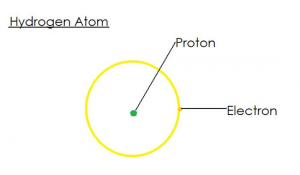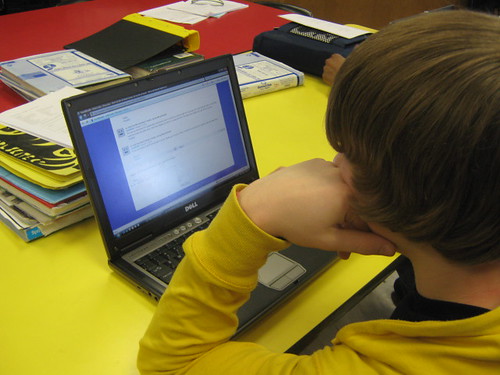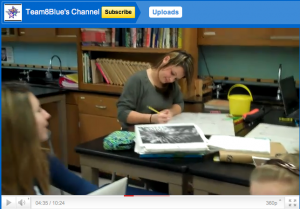I meant to post this earlier but better late than never! My class had the special experience of participating in a video conference this Spring. We “traveled” to Ohio to the Boonshoft Museum of Discovery simply by walking down the hall to the school library! That is where the video conference equipment was set up. Our wonderful librarian graciously allowed me to cover her tables with newspaper and make a big mess as we learned about oil spills from our instructor at the museum. She sent all of the materials for us to run a lab simulation of an oil spill along with a mini boom, skimmer, sorbants and dispersants to clean up our spills. The kids listened, took notes, asked questions, recorded observations, and discussed the pros and cons of various oil spill clean-up techniques. Our instructors, Liz and Amy did a great job of presenting the information with photographs, lab demonstrations, models, and inquiry activities. The experience of participating in a distance learning lesson was a first for my students and they seemed to really enjoy learning in this way. The students shared what they learned by making Creative Choice projects.
Rich and Meaningful Experiences
In his book, Make the Impossible Possible, Bill Strickland writes that in his schools they try to help the students reconnect with “the deepest possibilities of life.” He says “you can’t talk yourself or someone else into thinking this way.” Instead they let students “lose themselves in experiences that are rich and meaningful enough to make their broken lives whole again. We help them to see clearly the real potential they hold in their hands.”
Every teacher knows the futility of trying to use words to convince students that school is important or that if they just work hard at school their lives will somehow be better. We try to give our pep talks and motivational speeches but we know how ineffective they can be! I can’t convince students to be motivated and no matter how exciting I think a lesson is, some students in the room will still find it meaningless. When I read Bill Stricklands words they clarified for me just why some lessons I teach are so much more effective than others.
It all hinges on rich and meaningful experiences. It starts when we great the students at the door and find ways to make them feel comfortable in our classrooms. We start a lesson with a fun game and a little laughter to help them connect with their classmates in a friendly way. We show them how the lesson connects to their own lives and give them the opportunity to explore the topics that have special interest to them. We give the students the freedom to access content from the type of media they prefer such as books, magazines, videos, or websites, and allow them options to create projects that express their opinions and ideas. We take the time to plan and organize activities that are enriching and relevant. And although the results may not be immediate, I am hopeful that over time students get a sense of their value in the world and regain the knowledge that their lives are filled with exciting possibilities.
They did it their way.
 Part of my lesson plan today involved some basic note-taking. I had a nice template to use with Smart Notebook but my plans were just too teacher centered. I knew the students would be disinterested and might tune out the activity completely.
Part of my lesson plan today involved some basic note-taking. I had a nice template to use with Smart Notebook but my plans were just too teacher centered. I knew the students would be disinterested and might tune out the activity completely.
With a few computers available I was able to shift gears and offer the students some choices that transformed the lesson quickly. First, we played a vocabulary game from Quia.com. The students enjoy playing games and they are more ready to learn after a little fun. Next we did a few quiz-type questions on the SMART Notebook activity from the SMART Exchange to get them thinking about the topic. But when it came to the new vocabulary, where I would normally give them the notes they need, I offered the students a choice.
They could make a poster to show the vocabulary words, create a section on their group wiki page, make a Microsoft Publisher poster, make a Microsoft Word document, or use the available media anyway they liked in order to display the new vocabulary in a memorable way. Given only 20 minutes the students created many types of projects. They went one step further and added their own drawings, home-made graphics, and pictures from the Internet. They checked their understanding with students in other groups and they found additional information to supplement what their text books provided. The students were active and that means they were ready to learn!
Watching a Movie? Not what it sounds like!

Showing a movie in class used to be a way to fill time, calm kids down, or maybe an easy lesson to leave the substitute teacher. Today I had fun letting the students have very different learning experiences while…watching a movie!
Before starting the movie a student asked me if we could use Cover It Live to take notes while we watched the movie. In three minutes I was able to launch a live event and get them set up. Another student asked if she could use our Livescribe Pulse Pen to record notes and audio. Sure, why not? Another student decided to just type her notes on a Microsoft Word document. She added some pictures and used colorful headings. There were still 4 students who preferred writing their notes in their lab notebooks. Using the Interwrite Mobi slate it was easy to pause the movie for discussion as it streamed from Discovery Education and could even draw and add notes directly on the screen. When the movie was finished, I uploaded the Word document, the Pulse Pen pencasts, and the Cover It Live notes on our class wiki page.
What is changed when technology is incorporated into a typical lesson? Do the students learn more? Can the difference be quantified? These are the questions that we have to face in order to build a case for technology. We are asked to prove that the students do better when using technology. I don’t collect data, but I do make many observations. The students are happy to have a choice. They are engaged in the class activities. They are practicing their communication skills. And they are proud to show me what they create using technology. That is enough proof for me!
Energy Resources Project
Last week we worked on our energy resources research project. The students each researched a specific energy resource to share with the rest of the class. We found many great web sites to help with the research but many of them were confusing to navigate. What should the reader do when they finish reading the main section? Is there a “next page” link at the bottom, tabs across the top, a menu at the side, or links throughout the article that take you to other pages of information? The books from our library were very good but I wondered if the students were skimming to the point of not really getting much information. Reading is such an important part of becoming an independent learner but it takes a lot of practice! There are many reading strategies that can be used to help students grasp the concepts in science texts and articles like accessing prior knowledge, asking questions, predicting, and taking “talk back” notes. During a research project, however, the students are all reading different articles so it is difficult to guide them.
In our project students read three articles and organized their notes around “big ideas” that they came across as they read. They then shared their notes on a Google Doc (one shared account for the whole class) in which students with the same topics shared one document. Next, each student created a digital diagram to explain how their energy resource worked. Some used Paint, some chose Picnik, and others drew their pictures on paper and then took a digital picture with a camera. They uploaded these images to their Google Docs. Finally, students created Flip videos and online quizzes (testmoz.com) and embedded these on the Google Doc as well. I had planned to have them create Power Point presentations but their Google Docs worked just as well! Pictures, organized notes, and embedded video and quizzes. I put several of the projects on a Glog and posted all of them on our class wiki.
The use of technology in this project helped the students stay involved and motivated. They took more responsibility as they had to really collaborate on their Google Docs and were eager to share what they had learned from their research. Creating the diagrams forced them to apply what they were learning and the videos and quizzes helped them summarize their important findings.
Writing Science Stories
I love the idea of digital story telling! Although I don’t teach language arts, I love a good story as much as anyone else and there is nothing better to get kids fired up about their learning than letting them create stories. The stories we made in class today weren’t actually written but drawn on paper and the students talked and shared while they drew. They had to include the seven forms of energy in a super hero style story. First they created their hero and gave them a special weekness to make them more interesting and likeable! Next they drew a disaster for the hero to face. They filled in the rest with the hero’s adventure and finally they helped their hero save the world by restoring energy to the people! Hurray!
We used “Really Big Super Fun Science Paper” otherwise known as newsprint and began with some notes in one corner of the paper to be sure everyone had the background knowledge. I like the large paper because the kids aren’t afraid to mess up and they seem to try to fill up as much of the paper as they can. Think big! We all love when our students are engaged in what they are learning and I was really happy to hear the students chatting while using the vocabulary from our unit. While it is difficult to write and hold a conversation, the students today had no problem talking and drawing at the same time. Everyone was relaxed and enjoyed themselves. I’m hoping that they will remember their own stories and will have a positive attitude about the next lessons that look more deeply into the seven forms of energy.
The Flip Video cameras made it easy to record what the students were doing and everyone (almost) wanted to tell their story to the camera! It added an element of fun to the project and the students enjoyed sharing what they were learning.
Flip Video Project
This week we received four Flip Video Cameras from Digital Wish. The project I proposed was to create a science documentary using the cameras. The students will be allowed to sign out a camera overnight for the project. Each student will record something from their home and explain the science behind their example. One student wants to show Glo-Sticks and explain how temperature affects the intensity of the light they emit. Another wants to explain their hot-water heating system since we recently learned about heating systems in class. Each student will choose an example based on their interests and the lessons we have learned in our class. Later we will put the clips together to make our documentary.
I have heard people say that we shouldn’t push too much technology in schools because not everyone has a computer at home. But it is for the same reason that I think we should use technology as much as possible. For some students, school is the only time they get to use the computer. I am so happy that everyone will have the chance to take home a video camera for the project.
Do other teachers allow students to sign out classroom technology for use at home? I would love to hear about the experiences of other teachers. Please share if you have done a similar project! Any pointers?
Also, what examples of science at home do the students plan to share for their part of the project? Leave me a comment and let us know!
Integrating Technology

Today I’d like to simply share my class with you. The kids were all working so well that I grabbed a camera and tried to capture the atmosphere of creativity and discovery. They are using Pasco temperature sensors, Data Studio software, Wikispaces, Power Point, KidzZone Graphing, and Evernote as tools while they design their own experiments to study heat transfer.
Sharing
This week and next week I will be following the K12 Online Conference. The entire conference is held online! I don’t have to leave my family room! Can I really learn from my spot on the couch with my cat curled up next to me? Sure! I know from experience that we all learn more when we are comfortable and relaxed, so why not? Tonight, for example, the conversation was about sharing. Why is sharing such a risk? I think that teachers as well as students often question themselves and wonder if they are right or wrong. This makes sharing risky…what if what I’m sharing is wrong? We have to make a decision before we share openly. We have to decide that life is better when we share even if we are occasionally wrong. Let’s face it, you are a result of all of the knowledge, friendship, and love that was shared with you by others in your life. Dean Shareski, a speaker at the K12 Online Conference said that it is our moral imperative to share! The real secret is that when we share we actually receive much more than we give. You never know what opportunities will open up or what connections are in store. You have to share to find out!
Podcasting to Learn
Give a group of students a camera and ask them to make a short video explaining what they have learned. Your students jump right in thinking that this sounds fun but what actually happens is intense higher order thinking, problem solving, and analyzing. The students will need to review, compile ideas, organize, and even take their learning to a higher level as they grapple with the parts of the lesson that weren’t quite as clear as they had thought. They great thing about podcasting is that the students rarely realize how hard they are working and how much they are learning! They are exercising their creativity and independence and enjoying working with their classmates. The truth is, it matters very little to me how the podcast turns out, I know that the students are developing skills that are otherwise very difficult to practice in an authentic way. Skills like problem solving and communicating, collaborating and compromising. They are taking risks, putting their ideas on the line for other students to assess and maybe even critique. Students take pride in a finished podcast that showcases their learning. It becomes evidence of their success and gives them confidence that they can achieve even more.


